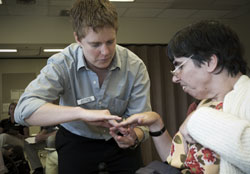Physical Therapy Degree Program Moves to Doctoral Level
As improved treatments help patients survive debilitating illnesses and devastating trauma, there's more need for physical therapy services that restore function, ameliorate pain, and limit permanent disabilities. Because the work of physical therapists has become more advanced, the UW and many other schools around the country are upgrading their degree programs in this field from a master's level to the doctoral level.
 |
| At UW Medical Center, a physical therapy student helps a patient gain more flexibility in her fingers. |
The Division of Physical Therapy, part of the UW School of Medicine's Department of Rehabilitation Medicine, now has an accredited program offering a Doctor of Physical Therapy (DPT) degree. This program replaces the Master of Physical Therapy program. The transition represents more than two years of work led by Dr. Mark Guthrie, associate professor and head of the Division of Physical Therapy.
"It was gratifying to get support from all over the campus," Guthrie said. "We helped people understand that this change was occurring in our profession, and they realized that if we wanted a top program we needed to make this change."
Nearly half of some 200 accredited physical therapy programs in the United States offer doctoral degrees, and many more are preparing to make the change. The increased complexity of rehabilitative care for injured or disabled people has fueled this shift in physical therapy education, Guthrie said, and requires future physical therapists to have more and higher-level coursework, as well as longer clinical internships.
The UW Doctor of Physical Therapy program consists of 150 course credits over 11 quarters, two quarters and 20 credits more than the master's program.
 |
| UW physical therapy students work in groups with volunteer patients to learn more about the needs of people with disabilities. |
Five new courses have also been added to the program as part of the switch to the doctorate: principles of pharmacology, advanced evaluation and assessment, a case-study course, an additional administration course, and an additional pediatrics course. Nine weeks of full-time clinical internship were also added, bringing that total to 37 weeks.
The UW program is already extremely competitive, Guthrie said. Admission requirements include a bachelor's degree, numerous prerequisite courses, and many hours of experience in the field. More than 200 prospective students applied for the 30 slots open for fall 2004 . Guthrie anticipates that the number of applicants will be higher next year.
The program stacks up well against others in the Pacific Northwest, Guthrie said, including doctoral programs at the University of Puget Sound in Tacoma and Eastern Washington University in Spokane. Graduates of the UW program, which is accredited by the American Physical Therapy Association Commission on Accreditation in Physical Therapy Education, will be eligible to take the national physical therapy licensing exam in any state.
"This is an excellent program, and one of the most difficult to get into," said Guthrie. "Our physical therapy faculty is truly exceptional. Over the past five years we have advanced this program significantly."
 |
| The role of physical therapists has advanced to meet the needs of patients who survive severe illnesses or trauma, or who were born with complex conditions. |
In addition to offering the higher-level degree, the physical therapy program has changed from state-supported to self-sustaining. With the field in such high demand, the program is an ideal academic program to be self-sustaining, Guthrie said.
"We will be funded entirely by tuition and whatever external funds we can garner," Guthrie said.
The Division of Physical Therapy was able to add one full-time faculty position. In addition to teaching responsibilities in therapeutic exercise and orthopaedic physical therapy, the new faculty member will conduct research in biomechanical and musculoskeletal issues in physical therapy.